AMD Dives Deep On High Bandwidth Memory - What Will HBM Bring AMD?
by Ryan Smith on May 19, 2015 8:40 AM ESTThe Net Benefits of HBM
Now that we’ve had a chance to talk about how HBM is constructed and the technical hurdles in building it, we can finally get to the subject of the performance and design benefits of HBM. HBM is of course first and foremost about further increasing memory bandwidth, but the combination of stacked DRAM and lower power consumption also opens up some additional possibilities that could not be pursued with GDDR5.
We’ll start with the bandwidth capabilities of HBM. The amount of bandwidth ultimately depends on the number of stacks in use along with the clockspeed of those stacks. HBM uses a DDR signaling interface, and while AMD is not disclosing final product specifications at this time, they have given us enough information to begin to build a complete picture.
| GPU Memory Math | |||||
| AMD Radeon R9 290X | NVIDIA GeForce GTX Titan X | Theoretical 4-Stack HBM1 | |||
| Total Capacity | 4GB | 12GB | 4GB | ||
| Bandwidth Per Pin | 5Gbps | 7Gbps | 1Gbps | ||
| Number of Chips/Stacks | 16 | 24 | 4 | ||
| Bandwidth Per Chip/Stack | 20GB/sec | 14GB/sec | 128GB/sec | ||
| Effective Bus Width | 512-bit | 384-bit | 4096-bit | ||
| Total Bandwidth | 320GB/sec | 336GB/sec | 512GB/sec | ||
| Estimated DRAM Power Consumption |
30W | 31.5W | 14.6W | ||
The first generation of HBM AMD is using allows for each stack to be clocked up to 500MHz, which after DDR signaling leads to 1Gbps per pin. For a 1024-bit stack this means a single stack can deliver up to 128GB/sec (1024b * 1G / 8b) of memory bandwidth. HBM in turn allows from 2 to 8 stacks to be used, with each stack carrying 1GB of DRAM. AMD’s example diagrams so far (along with NVIDIA’s Pascal test vehicle) have all been drawn with 4 stacks, in which case we’d be looking at 512GB/sec of memory bandwidth. This of course is quite a bit more than the 320GB/sec of memory bandwidth for the R9 290X or 336GB/sec for NVIDIA’s GTX titan X, working out to a 52-60% increase in memory bandwidth.
At the same time this also calls into question memory capacity – 4 1GB stacks is only 4GB of VRAM – though AMD seems to be saving that matter for the final product introduction later this quarter. Launching a new, high-end GPU with 4GB could be a big problem for AMD, but we'll see just what they have up their sleeves in due time.
What’s perhaps more interesting is what happens to DRAM energy consumption with HBM. As we mentioned before, R9 290X spends 15-20% of its 250W power budget on DRAM, or roughly 38-50W of power on an absolute basis. Meanwhile by AMD’s own reckoning, GDDR5 is good for 10.66GB/sec of bandwidth per watt of power, which works out to 30W+ via that calculation. HBM on the other hand delivers better than 35GB/sec of bandwidth per watt, an immediate 3x gain in energy efficiency per watt.
Of course AMD is then investing some of those gains back in to coming up with more memory bandwidth, so it’s not as simple as saying that memory power consumption has been cut by 70%. Rather given our earlier bandwidth estimate of 512GB/sec of memory bandwidth for a 4 stack configuration, we would be looking at about 15W of power consumption for a 512GB/sec HBM solution, versus 30W+ for a 320GB/sec GDDR5 solution. The end result then points to DRAM power consumption being closer to halved, with AMD saving 15-20W of power.
What’s the real-world advantage of a 15-20W reduction in DRAM power consumption? Besides being able to invest that in reducing overall video card power consumption, the other option is to invest it in increasing clockspeeds. With PowerTune putting a hard limit on power consumption, a larger GPU power budget would allow AMD to increase clockspeeds and/or run at the maximum GPU clockspeed more often, improving performance by a currently indeterminable amount. Now as fair warning here, higher GPU clockspeeds typically require higher voltages, which in turn leads to a rapid increase in GPU power consumption. So although having additional power headroom does help the GPU, it may not be good for quite as much of a clockspeed increase as one might hope.
Meanwhile the performance increase from the additional memory bandwidth is equally nebulous until AMD’s new product is announced and benchmarked. As a rule of thumb GPUs are virtually always memory bandwidth bottlenecked – they are after all high-throughput processors capable of trillions of calculations per second working with only hundreds of billions of bytes of bandwidth – so there is no doubt that the higher memory bandwidths of HBM will improve performance. However memory bandwidth increases currently don’t lead to 1:1 performance increases even on AMD’s current cards, and it’s unlikely to be any different on future products.
Throwing an extra wrinkle into matters, any new AMD product would be based on GCN 1.2 or newer, which introduced AMD’s latest generation of color compression technology. The net result is that on identical workloads, memory bandwidth pressure is going down exactly at the same time as memory bandwidth availability is going up. AMD will end up gaining a ton of effective memory bandwidth – something that will be very handy for high resolutions – but it also makes it impossible to predict what the final performance impact might be. Still, it will be interesting to see what AMD can do with a 2x+ increase in effective memory bandwidth for graphics workloads.
The final major benefit AMD is looking at taking advantage of with HBM – and that this point they’re not even being subtle about – is new form factor designs from the denser designs enabled by HBM. With the large GDDR5 memory chips replaced with much narrower HBM stacks, AMD is telling us that the resulting ASIC + RAM setups can be much smaller.
How much smaller? Well 1GB of GDDR5, composed of 2Gbit modules (the standard module size for R9 290X) would take up 672mm2, versus just 35mm2 for the same 1GB of DRAM as an HBM stack. Even if we refactor this calculation for 4Gbit modules – the largest modules used in currently shipping video cards – then we still end up with 336mm2 versus 35mm2, which is still a savings of 89% for 1GB of DRAM. Ultimately the HBM stack itself is composed of multiple DRAM dies, so there’s still quite a bit of silicon in play, however its 2D footprint is reduced significantly thanks to stacking.
By AMD’s own estimate, a single HBM-equipped GPU package would be less than 70mm X 70mm (4900mm2), versus 110mm X 90mm (9900mm2) for R9 290X. Throw in additional space savings from the fact that HBM stacks don’t require quite as complex power delivery circuitry, and the card space savings could be significant. By our reckoning the total card size will still be fairly big – all of those VRMs and connectors need to go somewhere – but there is potential for significant savings. What AMD intends to do with those savings remains to be seen, but with apologies to AMD on this one, NVIDIA has already shown off their Pascal test vehicle for their mezzanine connector design, and it goes without saying that such a form factor opens up some very interesting possibilities.
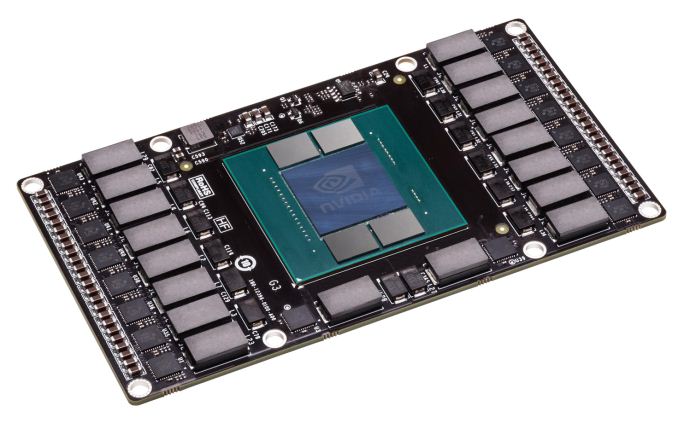
With apologies to AMD: NVIDIA’s Pascal Test Vehicle, An Example Of A Smaller, Non-Traditional Video Card Design
Finally, aftermarket enthusiasts may or may not enjoy one final benefit from the use of HBM. Because the DRAM and GPU are now on the same package, AMD is going to be capping the package with an integrated heat spreader (IHS) to compensate for any differences in height between the HBM stacks and GPU die, to protect the HBM stacks, and to supply the HBM stacks with sufficient cooling. High-end GPU dies have been bare for some time now, so an IHS brings with it the same kind of protection for the die that IHSs brought to CPUs. At the same time however this means it’s no longer possible to make direct contact with the GPU, so extreme overclockers may come away disappointed. We’ll have to see what the shipping products are like and whether in those cases it’s viable to remove the IHS.
Closing Thoughts
Bringing this deep dive to a close, as the first GPU manufacturer to be shipping an HBM solution – in fact AMD expects to be the only vendor to ship an HBM1 solution – AMD has set into motion some very aggressive product goals thanks to the gains from HBM. Until we know more about AMD’s forthcoming video card I find it prudent to keep expectations in check here, as HBM is just one piece of the complete puzzle that is a GPU. But at the same time let’s be clear here: HBM is the future memory technology of GPUs, there is potential for significant performance increases thanks to the massive increase in memory bandwidth offers, and for roughly the next year AMD is going to be the only GPU vendor offering this technology.
AMD for their part is looking to take as much of an advantage of their lead as they can, both at the technical level and the consumer level. At the technical level AMD has said very little about performance so far, so we’ll have to wait and see just what their new product brings. But AMD is being far more open about their plans to exploit the size advantage of HBM, so we should expect to see some non-traditional designs for high-end GPUs. Meanwhile at the consumer level, expect to see HBM enter the technology lexicon as the latest buzzword for high-performance products – almost certainly to be stamped on video card boxes today just as GDDR5 has been for years – as AMD looks to let everyone know about their advantage.
Meanwhile shifting gears towards the long term, high-end GPUs are just the first of what AMD expects to be a wider rollout for HBM. Though AMD is not committing to any other products at this time, as production ramps up and costs come down, HBM is expected to become financially viable in a wider range, including lower-end GPUs, HPC products (e.g. FirePro S and AMD’s forthcoming HPC APU), high-end communications gear, and of course AMD’s mainstream consumer APUs. As lower-margin products consumer APUs will likely be among the farthest off, however in the long-run they may very well be the most interesting use case for HBM, as APUs are among the most bandwidth-starved graphics products out there. But before we get too far ahead of ourselves, let’s see what AMD is able to do with HBM on their high-end video cards later this quarter.


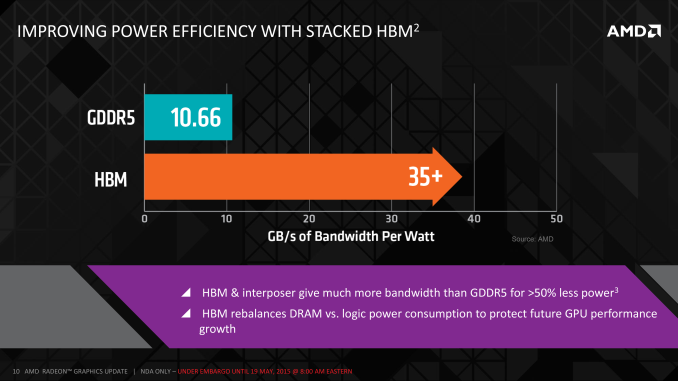
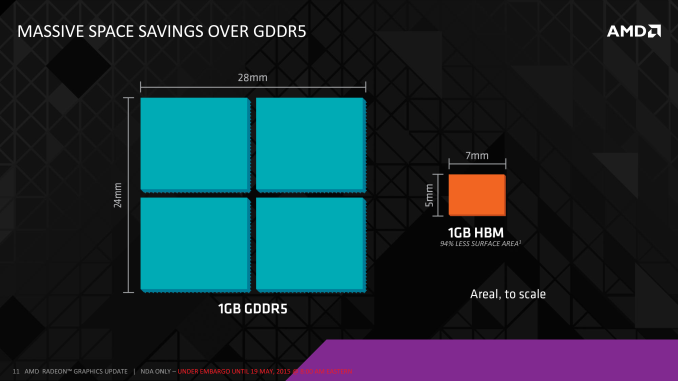
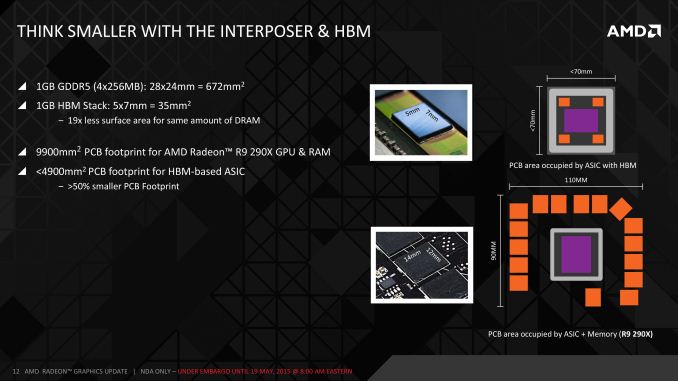
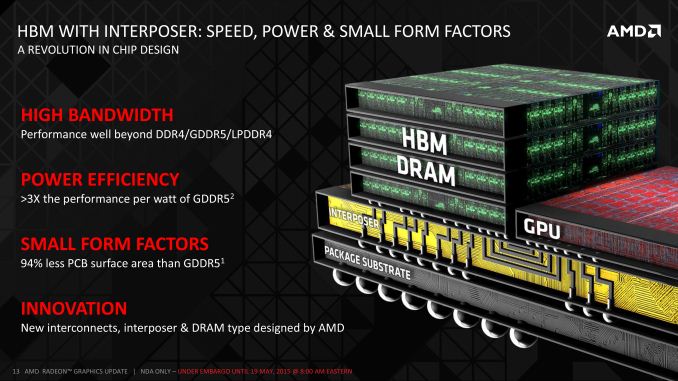








163 Comments
View All Comments
jjj - Tuesday, May 19, 2015 - link
"First part of the solution to that in turn was to develop something capable of greater density routing, and that something was the silicon interposer. ""Moving on, the other major technological breakthrough here is the creation of through-silicon vias (TSVs). "
You guys are acting like interposers and TSV were created by AMD and Hynix for this, it's hugely misleading the way you chose to phrase things.
And ofc, as always when you do this kind of article (Aptina, Synaptics, Logitech and a few more in the last few years), it's more advertising than anything else.You don't talk about other similar technologies ,existing or potential, you just glorify the one you are presenting.
Crunchy005 - Tuesday, May 19, 2015 - link
This isn't an article on HBM itself but AMDs next gen cards. They are focusing on AMD becasue of that fact. If this were about HBM itself i'm sure they would talk about other technologies out their as well. Don't criticize because they are staying on topic in the article.testbug00 - Tuesday, May 19, 2015 - link
a side note for the article, ATI also was the main developer of GDDR3, with JEDEC helping a little. Nvidia launched with it first, but, ATI __DID__ most of the design work.testbug00 - Tuesday, May 19, 2015 - link
Having finished the article, I was also under the impression that high clock GDDR5 used 2-2.5 watts per chip on the board. I don't see what 7GBps GDDR5 with 50% more chips would use only 5% more power. (currently on graph 290 == 16 chips @5GBps, ~30W. Titan X = 24 chips @7GBps, ~31.5W).Given AMD's ~15-20% for the 290x, I would put that at around 35-50W, while NVidia's solution is at least 50W. Of course, I could be wrong!
testbug00 - Tuesday, May 19, 2015 - link
As a note, I get that you used the GDDR5 bandwidth/W you can get... However, that's likely at the best point in the pref/watt curve. I suspect that's under 5GBps, based on AMD's claimed GDDR5 consumption on the 290(X) and their memory clock.Which, would put AMD's under that number, and, NVidia's further under that number.
testbug00 - Tuesday, May 19, 2015 - link
Oh, and, here the slide you have that "proves" it: http://images.anandtech.com/doci/9266/HBM_9_Compar...That means at 7GBps, at max bandwidth/watt, the Titan X should be using ~63 watts of power (28/10.66) * 24 = 63.04
Ryan Smith - Tuesday, May 19, 2015 - link
They're rough estimates based on power consumption per bit of bandwidth and should be taken as such. Titan X has more chips, but it doesn't have to drive a wider memory bus.HighTech4US - Tuesday, May 19, 2015 - link
Facts have never gotten in the way of testbug's anti-Nvidia drivel.testbug00 - Tuesday, May 19, 2015 - link
So, should I assume that GDDR5 chips don't use power if you don't make a wider bus? And that 7GBps is the best Bandwidth/watt of GDDR5? Or that GDDR5 power consumption doesn't change when you raise or lower the clockspeed?Nvidia's generalized power is just easier to calculate because they use 7GBps. Anyhow, my guesstimations for the 290x is that it uses is 32W given perfect power scaling from 5GBps to 7GBps and that it has less chips to run voltage.
The reality is probably AMD's is 40-50W and NVidia is 50-60W. Running more GDDR5 chips at higher clockspeeds, even on a smaller bus, should result in higher power usage.
I have rose tinted glasses, I also do have a brain.
silverblue - Tuesday, May 19, 2015 - link
It's quite the role-reversal, really. Back in the GT 200 days, NVIDIA were throwing out cards with wider memory buses, and AMD showed them that it was (mostly) unnecessary.Whichever solution uses the most power for GDDR5 stands to gain the most with a move to HBM. I'd be interested in seeing how much juice the memory on a 12GB card uses...